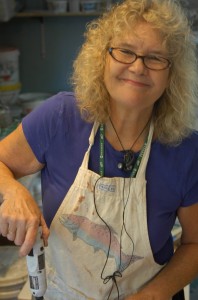 Linda Lowry Shaver began learning about clay in Pasadena, California in 1970 by first taking a local community college ceramics class. Shortly thereafter she opened a retail and wholesale business and for several years she made and sold tableware and decorative pottery in the Los Angeles area.
Linda Lowry Shaver began learning about clay in Pasadena, California in 1970 by first taking a local community college ceramics class. Shortly thereafter she opened a retail and wholesale business and for several years she made and sold tableware and decorative pottery in the Los Angeles area.
In 1973 Linda moved to Lane County, Oregon. Here she and her partners built a large wood-fired kiln and made ware for wholesale distribution. The Saturday Market in Eugene also provided an outlet for their pottery and with the opening of the Portland Saturday Market a few years later, Linda began making weekly trips to Portland.
During the years from 1974 to 1980 Linda continued to make her pottery in her Springfield studio; selling her wares at the Eugene Saturday Market and many of the art fairs and festivals in the Pacific Northwest. During this time she also served as one of the Saturday Market’s board members and as its executive director for one year.
With the birth of her first child, Linda took a break from pottery. While raising a family Linda’s creative interests moved to textiles and quilting. Her quilts were displayed in the annual Pioneer Quilting Show in Eugene.
Linda resumed pottery in 1989 and found that the time away had given her a new perspective on her work in clay. Whereas her previous work was primarily wheel thrown and very utilitarian in look, her new pieces bring the look and feel of textiles to the clay and most are hand built from slabs using a wide variety of texturing surfaces in the formation. With this more limited production came a switch from years of gas and wood firing to the electric kiln. Her current functional pottery work is predominately handbuilt, buttery white with green and cobalt accents with a touch of rose or purple.
In 2009 She began to explore using slab clay as a canvas for images. Her new work focuses on the use of stains and oxides mixed with water and painted directly on bone dry clay. The paintings are changed in the firing which reaches over 2000 degrees F. The oxides may totally change or loose color, the clay may warp or crack, the painting may be a loss. After firing the painting is mounted with screws and epoxy to local hard wood. The wood is from Urban Lumber a, a local Springfield company who harvest, mill and dry local wood. Please see the Clayscape gallery for individual pieces.
She sells her work through local shows and galleries.
You can contact her at : waterstclay@gmail.com